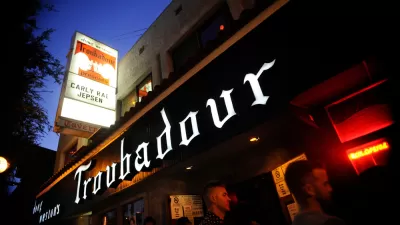Two well-known Los Angeles civic leaders advocate a new framework for understanding the built environment and landscape of Los Angeles, setting a trajectory for sustainable development.
Los Angeles’ urbanism is difficult to unravel, characterized typically as suburban, messy, and poorly planned. But how can we understand its origins and where the city is moving today? How does the landscape of Los Angeles come to define its trajectory? Two of LA’s prominent civic leaders—Daniel Rosenfeld, President of The George Crenshaw Development Project, and Paul Vandeventer, President & CEO of Community Partners—have created a framework in the following The Planning Report article to anchor the city’s physical timeline. Their observations offer insight into what they call a “Fifth Covenant” between Angelenos and the land, setting the stage for sustainable growth.
A convenant? Vandeventer and Rosenfeld respond, "Throughout history, every community has served as a steward for the land it inhabits. The people of Los Angeles are no different. Their stewardship not only continues a covenant handed down from previous generations, but also represents a commitment to future Angelenos. A covenant with the land suggests a shared conviction across generations that responsibly managing the land matters. Stewardship means both knowledge of the past and wisdom inform decisions that shape the future. We’ve created something remarkable in Los Angeles despite wavering in our stewardship over the decades between the poles of mastery and drift."
An appreciation for urban living coupled with investment in a growing mass transit system and a revitalized Downtown mark signs of this new covenant. As Los Angeles evolves over the next century, residents, businesses, and community stakeholders have an opportunity to recommit themselves to their city and to the environment.
FULL STORY: Advocating a New Planning Covenant for Los Angeles

Planetizen Federal Action Tracker
A weekly monitor of how Trump’s orders and actions are impacting planners and planning in America.

Restaurant Patios Were a Pandemic Win — Why Were They so Hard to Keep?
Social distancing requirements and changes in travel patterns prompted cities to pilot new uses for street and sidewalk space. Then it got complicated.

Map: Where Senate Republicans Want to Sell Your Public Lands
For public land advocates, the Senate Republicans’ proposal to sell millions of acres of public land in the West is “the biggest fight of their careers.”

Maui's Vacation Rental Debate Turns Ugly
Verbal attacks, misinformation campaigns and fistfights plague a high-stakes debate to convert thousands of vacation rentals into long-term housing.

San Francisco Suspends Traffic Calming Amidst Record Deaths
Citing “a challenging fiscal landscape,” the city will cease the program on the heels of 42 traffic deaths, including 24 pedestrians.

California Homeless Arrests, Citations Spike After Ruling
An investigation reveals that anti-homeless actions increased up to 500% after Grants Pass v. Johnson — even in cities claiming no policy change.
Urban Design for Planners 1: Software Tools
This six-course series explores essential urban design concepts using open source software and equips planners with the tools they need to participate fully in the urban design process.
Planning for Universal Design
Learn the tools for implementing Universal Design in planning regulations.
Heyer Gruel & Associates PA
JM Goldson LLC
Custer County Colorado
City of Camden Redevelopment Agency
City of Astoria
Transportation Research & Education Center (TREC) at Portland State University
Camden Redevelopment Agency
City of Claremont
Municipality of Princeton (NJ)




























